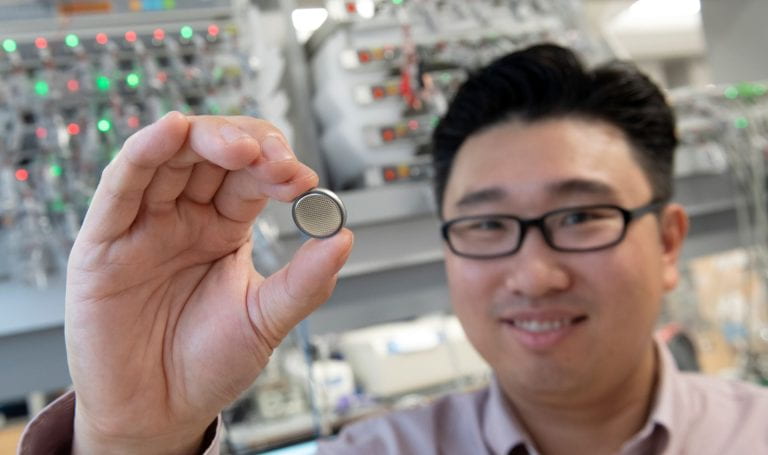
Photo: Nicole Fandel
Smaller, faster, better: Nanoscale batteries may power future technology
Inside modern cell phones are billions of nanoscale switches that flip on and off, allowing the phone to function. These switches, called transistors, are controlled by an electrical signal that is delivered via a single battery. This configuration of one battery to power multiple components works well for today’s technologies, but there is room for improvement. Each time a signal is piped from the battery to a component, some power is lost on the journey. Coupling each component with its own battery would be a much better setup, minimizing energy loss and maximizing battery life. However, in the current tech world, batteries are not small enough to permit this arrangement — at least not yet.
Now, MIT Lincoln Laboratory and the MIT Department of Materials Science and Engineering have made headway in developing nanoscale hydrogen batteries that use water-splitting technology. With these batteries, the researchers aim to deliver a faster charge, longer life, and less wasted energy. In addition, the batteries are relatively easy to fabricate at room temperature and adapt physically to unique structural needs.
“Batteries are one of the biggest problems we’re running into at the Laboratory,” says Raoul Ouedraogo, who is from Lincoln Laboratory’s Advanced Sensors and Techniques Group and is the project’s principal investigator. “There is significant interest in highly miniaturized sensors going all the way down to the size of a human hair. We could make those types of sensors, but good luck finding a battery that small. Current batteries can be round like coin cells, shaped like a tube, or thin but on a centimeter scale. If we have the capability to lay our own batteries to any shape or geometry and in a cheap way, it opens doors to a whole lot of applications.”
The battery gains its charge by interacting with water molecules present in the surrounding air. When a water molecule comes in contact with the reactive, outer metal section of the battery, it is split into its constituent parts — one molecule of oxygen and two of hydrogen. The hydrogen molecules become trapped inside the battery and can be stored until they are ready to be used. In this state, the battery is “charged.” To release the charge, the reaction reverses. The hydrogen molecules move back through the reactive metal section of the battery and combine with oxygen in the surrounding air.
So far, the researchers have built batteries that are 50 nanometers thick — thinner than a strand of human hair. They have also demonstrated that the area of the batteries can be scaled from as large as centimeters to as small as nanometers. This scaling ability allows the batteries to be easily integrated near transistors at a nano- and micro-level, or near components and sensors at the millimeter- and centimeter-level.
“A useful feature of this technology is that the oxide and metal layers can be patterned very easily into nanometer-scale custom geometries, making it straightforward to build intricate battery patterns for a particular application or to deposit them on flexible substrates,” says Annie Weathers, a staff member of the laboratory’s Chemical, Microsystem, and Nanoscale Technologies Group, who is also involved in the project.
The batteries have also demonstrated a power density that is two orders of magnitude greater than most currently used batteries. A higher power density means more power output per the volume of the battery.
“What I think made this project work is the fact that none of us are battery people,” says Ouedraogo. “Sometimes it takes somebody from the outside to see new things.”
Currently, water-splitting techniques are used to generate hydrogen for large-scale industrial needs. This project will be the first to apply the technique for creating batteries, and at much smaller scales.
The project was funded via Lincoln Laboratory’s Technology Office Energy Initiative and has entered into phase two of development, which includes optimizing the batteries further and integrating them with sensors.
Learn more: Smaller, faster, better: Nanoscale batteries may power future technology
The Latest on: Nanoscale hydrogen batteries
[google_news title=”” keyword=”nanoscale hydrogen batteries” num_posts=”10″ blurb_length=”0″ show_thumb=”left”]
via Google News
The Latest on: Nanoscale hydrogen batteries
- Pioneering professor at The University of Warwick announced as Fellow of the Royal Societyon May 16, 2024 at 10:18 am
The resulting knowledge of nanoscale structure-activity is important for the development of next generation electrochemical devices – spanning fuel cells, batteries and sensors ... could be crucial in ...
- Energy and the Environment Newson May 14, 2024 at 5:00 pm
Trash to Treasure -- Researchers Turn Metal Waste Into Catalyst for Hydrogen Apr. 16 ... that could have implications for improving ... Nanoscale Movies Shed Light on One Barrier to a Clean ...
- This autonomous DNA nano turbine could redefine drug deliveryon May 13, 2024 at 11:42 am
Turbines, from macroscopic to nanoscale, harness kinetic energy and have diverse applications. Nanoscale turbines, ...
- When nano- meets climate technologyon April 22, 2024 at 4:59 pm
The warmest years since global temperature records were first established, in 1880, have all unfolded since 2010, with the period from 2014 to 2022 standing out as the nine warmest years.
- Trash To Treasure: Researchers Turn Metal Waste Into Catalyst for Green Hydrogenon April 16, 2024 at 5:01 pm
These platinum atoms then come together into nanoparticles that fit snugly into the nanoscale grooves. It is remarkable that we are able to produce hydrogen from water using only a tenth of the amount ...
- Nanoscale movies shed light on one barrier to a clean energy futureon April 10, 2024 at 5:00 pm
Called an electrolyzer, it separates hydrogen out of water ... able to see the process of this catalyst breaking down with nanoscale resolution,” Moreno-Hernandez said. Over the course of ...
- Nanoscale Horizonson October 18, 2023 at 10:37 pm
Nanoscale Horizons Communications must include a separate ‘new concepts’ statement. This statement should be a paragraph of no more than 200 words and should address the following questions: What new ...
- Nanorippled graphene becomes a catalyston March 23, 2023 at 6:06 am
Published this week in the Proceedings of the National Academy of Sciences (PNAS), the research has shown that graphene with nanoscale corrugations of its surface can accelerate hydrogen splitting as ...
- Mirroring the power of plants to use carbon dioxideon October 5, 2022 at 6:24 am
One particularly exciting form of artificial photosynthesis is using solar power to split water and thereby produce hydrogen ... high activity and stability. Batteries are another key technology ...
- Kate Queeneyon May 28, 2022 at 3:48 am
One part of this project focuses on developing robust and flexible ways to simultaneously vary both these surface properties, using an aqueous process discovered in her lab to create regular arrays of ...
via Bing News











